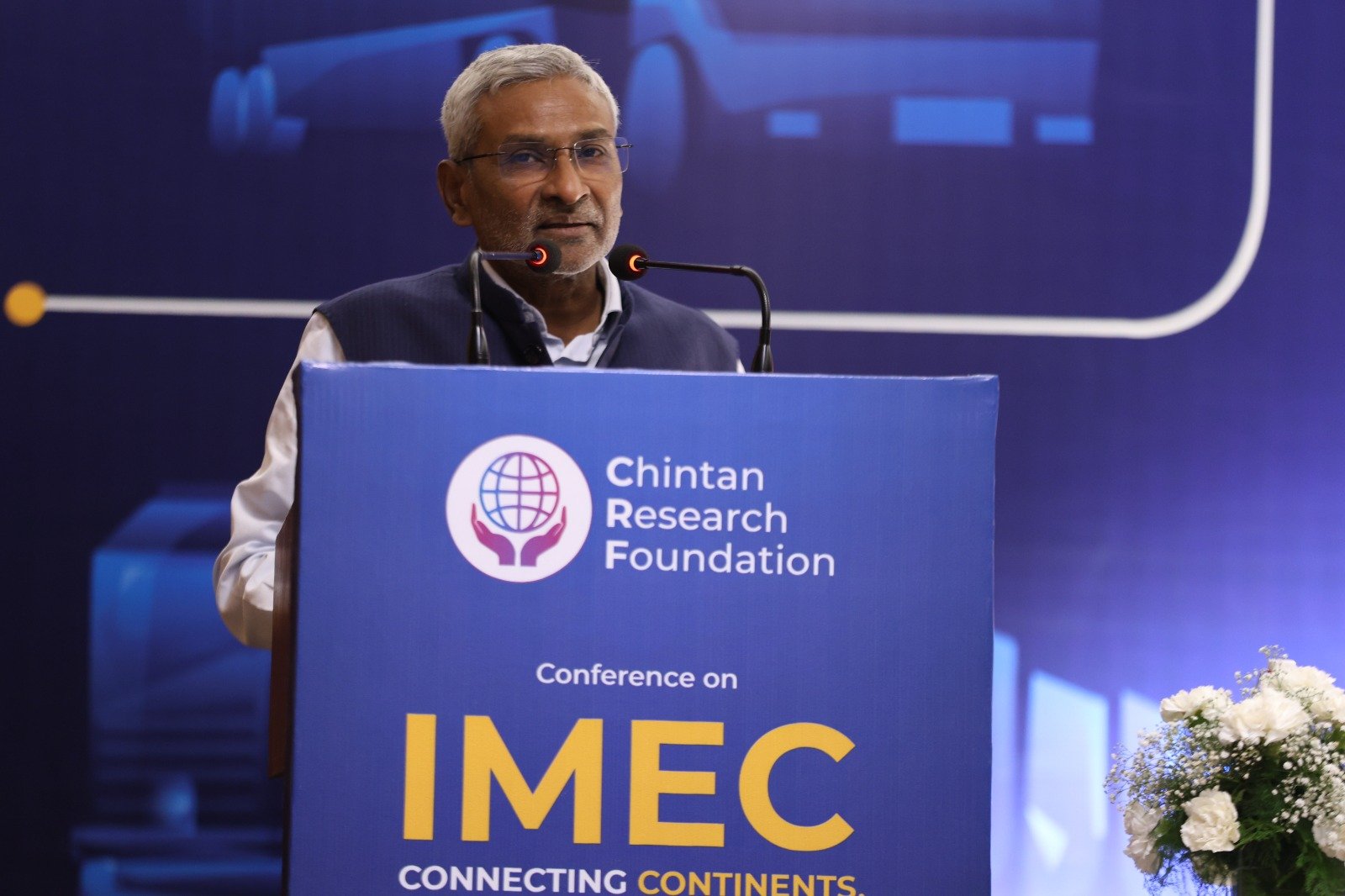
At a time when the global landscape is undergoing a profound transformation driven by the imperatives of economic integration and geopolitical rebalancing, the India-Middle East-Europe Economic Corridor (IMEC) emerges as a timely and ambitious initiative. Addressing a Conference on IMEC: Connecting Continents, Unlocking Opportunities, organised by Chintan Research Foundation in New Delhi on 4 June 2025, Shri Dammu Ravi, Secretary (Economic Relations), Ministry of External Affairs, Government of India, offered an overview of IMEC’s origins, potential, and India’s pivotal role in it.
The genesis of IMEC, he elaborated, can be traced back to early dialogues within the I2U2 initiative—bringing together India, Israel, the United Arab Emirates, and the United States. From those nascent conversations emerged the vision of a wider corridor connecting Asia, the Middle East, and Europe—eventually culminating in its formal announcement during India’s presidency of the G20 in 2023. That same presidency also witnessed another historic achievement: the inclusion of the African Union as a permanent member of the G20.
Shri Ravi underlined how the geopolitical shifts in the Middle East—especially post-Abraham Accords, the Saudi-Iran détente, and growing diplomatic dynamism in the Gulf—helped create fertile ground for initiatives like IMEC, aimed at enhancing connectivity and fostering regional stability.
Placing IMEC in the broader geopolitical and economic context, Shri Ravi pointed out that while it is often viewed through the lens of physical infrastructure, its true significance lies in the way it weaves into a larger “tapestry of transnational corridors shaping the 21st-century global economy.” India’s involvement in multiple connectivity projects—the International North-South Transport Corridor (INSTC), the Chabahar Port, the Lobito Corridor in Africa, and the India-Myanmar-Thailand Trilateral Highway—underscores a deep strategic commitment to fostering seamless regional and intercontinental linkages.
Yet, he cautioned that such corridors do not operate in a vacuum. “They are shaped by both opportunities and challenges—regional tensions, supply chain vulnerabilities, and the need for collective strategic foresight.” Drawing a parallel with historical trade disruptions, Shri Ravi reminded the audience that choke points in the past led to the discovery of new routes. Today’s choke points—from the Red Sea to the Strait of Malacca—necessitate building alternative, resilient routes like IMEC that can withstand the tremors of geopolitical instability.
In comparing IMEC to other global infrastructure and connectivity initiatives, Shri Ravi was candid in his assessment. He acknowledged the scale and financial might behind China’s Belt and Road Initiative (BRI), but also highlighted the fundamental difference in approach: “Unlike the BRI—driven by a single country with vast resources—IMEC is a collaborative initiative involving multiple democracies. As such, its progress may be slower, but its foundation is rooted in shared values and mutual benefit. That, in the long run, may prove more sustainable.”
India’s role, he emphasised, is not merely geographical but profoundly strategic. Linking India to the UAE, Saudi Arabia, Jordan, Israel, and Europe via Greece, IMEC places India at the very heart of a new economic architecture. On the eastern side, India’s connection to Myanmar and Thailand through the trilateral highway integrates IMEC into the broader ASEAN framework.
As India charts its course toward becoming a $30 trillion economy by 2047, infrastructure corridors like IMEC are no longer optional—they are imperative. Shri Ravi was clear-eyed about the scale of the challenge. “Today, China accounts for about 30% of global manufacturing; India stands at just 3%. If we are to become the ‘factory of the world,’ we must scale up industrial corridors, boost our manufacturing capacity, and link these hubs through corridors like IMEC.”
Describing IMEC as a “multimodal economic corridor,” Shri Ravi illustrated its multidimensional nature—encompassing ports, railways, highways, airports, digital networks, and energy grids. The corridor promises to unlock hinterland markets, attract significant investment, spur manufacturing, create jobs, and foster stronger people-to-people ties. In his words, “Prosperity along the corridor will foster political stability. Just as we have seen with the European Union and ASEAN, economic cooperation can build the foundation for lasting peace.”
In a rousing conclusion, Shri Dammu Ravi framed IMEC not just as an economic blueprint but as a philosophical and strategic vision. “IMEC represents more than an infrastructure project. It is a strategic vision for a more connected, resilient, and inclusive world. For India, it aligns with our Act East and Link West policies, enhances our economic engagement, and reinforces our role as a bridge between regions.”
With the world at a crossroads, IMEC offers a pathway not only to prosperity but also to peace. As Shri Ravi eloquently put it, “Let us approach IMEC not just as a corridor of commerce—but as a pathway to peace, progress, and partnership.”
In a world often divided by ideology and competition, India’s IMEC vision—anchored in collaboration, shared prosperity, and democratic values—may well serve as a model for inclusive globalisation in the years ahead.
Leave a Reply